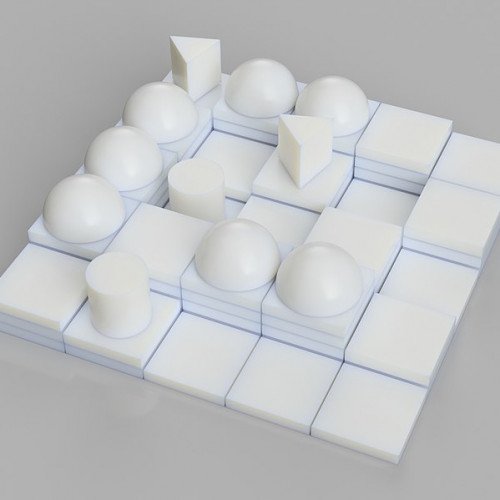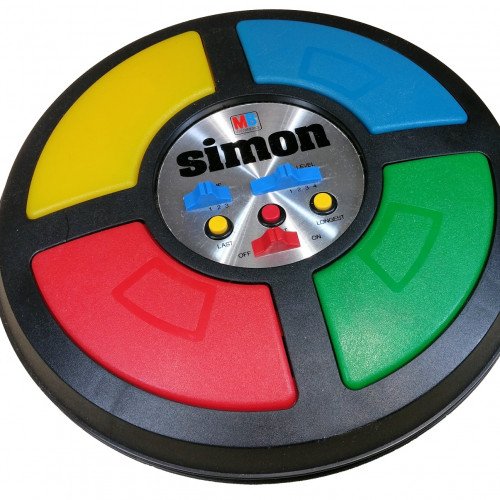SANTORINI VS SIMON

SANTORINI
Santorini is an abstract strategy board game for 2-4 players designed and released in 2004 by Gordon Hamilton and republished via Kickstarter in 2016 by Roxley Games. Inspired by the architecture of cliffside villages on Santorini Island in Greece, and primarily designed for two players, the game is played on a grid where each turn players build a town by placing building pieces up to three levels high. To win the game, players must move one of their two characters to the third level of the town. Each turn of play involves moving one of your two pieces around a 5-by-5 grid each turn and then placing a tile adjacent to the moved piece, building up that spot of the board. On subsequent turns, pieces may be moved onto one of these built-up tiles, but only one level up at a time. Pieces may also be moved down any number of levels. Players may also place a special dome tile on top of a three-level building, which prevents a player from moving onto that spot for the remainder of the game. The primary winning condition is to get one of your pieces onto the third level, though players may also win if their opponent is unable to make a move. The Roxley Games version of Santorini introduced a god powers variant, which gives each player a unique way to break the rules. After being directly released and sold by Hamilton in 2004, Roxley Games ran a Kickstarter campaign during March-April 2016, drawing over 7,100 backers and raising over C$700,000, the most successful Kickstarter campaign ever based in Alberta. While the original release used plain white blocks as components, the Roxley version featured an enhanced cartoon-like look to the game, which Hamilton credits for success of the Kickstarter campaign. The game was released in retail outlets in January 2017.
Statistics for this Xoptio

SIMON
Simon is an electronic game of memory skill invented by Ralph H. Baer and Howard J. Morrison, working for toy design firm Marvin Glass and Associates, with software programming by Lenny Cope. The device creates a series of tones and lights and requires a user to repeat the sequence. If the user succeeds, the series becomes progressively longer and more complex. Once the user fails or the time limit runs out, the game is over. The original version was manufactured and distributed by Milton Bradley and later by Hasbro after it took over Milton Bradley. Much of the assembly language code was written by Charles Kapps, who taught computer science at Temple University and also wrote one of the first books on the theory of computer programming. Simon was launched in 1978 at Studio 54 in New York City and was an immediate success, becoming a pop culture symbol of the 1970s and 1980s. Ralph H. Baer and Howard J. Morrison were introduced to Atari's arcade game Touch Me at the Music Operators of America (MOA) trade show in 1976. Baer said of the product, "Nice gameplay. Terrible execution. Visually boring. Miserable, rasping sounds." The prototype built by Baer used the low cost Texas Instruments TMS 1000 microcontroller chip, which was in many games of the 1970s. Lenny Cope, who was one of Ralph H. Baer's partners, programmed the core of the game, titled Follow Me at the time. Baer developed the tones of the game, inspired by the notes of a bugle. When they pitched the demo, an 8-by-8-inch console, to the Milton Bradley Company the name of the game was changed to Simon. Simon debuted in 1978 at a retail price of $24.95 (equivalent to $98 in 2019) and became one of the top-selling toys that Christmas. U.S. Patent 4,207,087: "Microcomputer controlled game", was granted in 1980. Milton Bradley soon capitalized on the original with both the smaller-sized Pocket Simon and the expanded, eight-button Super Simon. Many variants of Simon have been made since Hasbro acquired Milton Bradley in the 1980s, building on the possibilities offered by advances in technology. The original Super Simon was reinvented in the late 1990s as a hexagonal unit with six buttons. 2000 saw Simon Squared (or Simon2), a unit with the four traditional buttons on one side, and a set of eight smaller buttons on the other. In 2004, Hasbro released the Simon Stix. The game features two electronic sticks (modeled after drumsticks), an emphasis on the musical part of the game, and features four levels of play. In 2005, Hasbro released Simon Trickster (also known as Simon Tricks in Europe and in the UK, and as Simon Genius in Brazil), which features four game modes, in a similar fashion to another Hasbro game, Bop It, and colored lenses instead of buttons. "Simon Classic" mode plays up to 35 tones(notes). "Simon Bounce" is similar to "Simon Classic", but instead the colors of the lenses change. "Simon Surprise" is one of the most difficult games in the unit. Every lens becomes the same color and the player has to memorize the location. "Simon Rewind" requires the player to memorize the sequence backwards. During each game, the player is paid a compliment after a certain number of tones completed. On reaching five and eleven tones, the computer will randomly choose "Awesome!", "Nice!", "Sweet!" or "Respect!". On reaching 18 tones, the game will play a victory melody three times. On reaching the ultimate 35 tones, the game will play the victory melody again and will say "Respect!". If the player fails to memorize the pattern or fails to press the right color within the time limit, the game will play a crashing sound and the game will say "Later!".